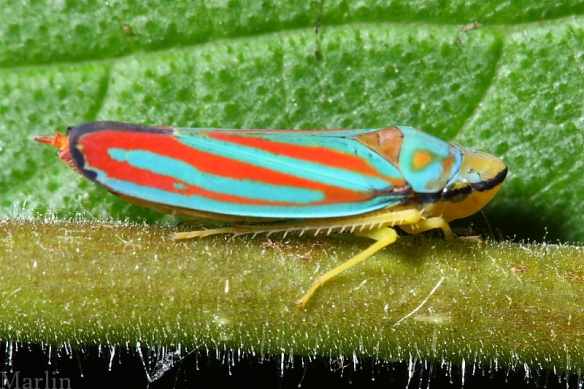Every now and then someone will ask what I do here in the Entomology Department at the California Academy of Sciences. Sometimes I say, “just lookin’ at bugs” or I stare blankly at them, slowly back up, and then run away. But usually I relate it to working in a library, only instead of books the walls are stacked with row upon row, millions upon millions of preserved insects. Researchers from all over the world “check-out” or borrow certain groups of insects, specifically ones in their area of expertise, for identification and study.
But there are some peculiarities to working in an Entomology collection. Translation: things sometimes get a little weird.
On a typical day I might peer into my microscope and see something like this:

“Someone identify me!”
These googley-eyed chaps are an assortment of insects in the order Homoptera. The so-called “true-bugs”, insects in this very large order suck up plant sap with a pointy beak-like mouth, and include such well known insects as cicadas and aphids, as well as the ones you see illustrated here, commonly known as leafhoppers and planthoppers.
See this little guy with the bristles on his hind leg?

That’s a leafhopper in the family Cicadellidae. If you’ve ever walked through grass on a spring day, you’ve likely seen these guys in action, doing what the do best: hoppin’! They are by far the most common Homopteran family I see under my microscope. Not only that, some of them have amazingly beautiful colors.

Rhododendron Leafhopper (Graphocephala fennahi)

Red-banded Leafhopper (Graphocephala coccinea)

Leafhopper (Versigonalia ruficauda)
Several years ago, Entomologists at the Academy began a project to map arthropod diversity on the Island of Madagascar in order to identify conservation hotspots there. Sounds straightforward, but it’s actually quite revolutionary! Until recently, insects were typically overlooked in conservation assessments, despite the fact that they make up the majority of life on the planet.
Biologists in Madagascar collect thousands of specimens that they then ship to us at the Academy. Big bags labeled “Coleoptera”, “Lepidoptera”, “Hymenoptera”, etc. brimming with vials of specimens preserved in alcohol come pouring into our lab. That’s where my job comes in, because I get to wrangle the miscellaneous Homopterans and sort them into smaller and more manageable groups that can then be shipped to taxonomists all over the world.
Here’s a bright pink specimen that belongs in the family Flatidae. They often come in shades of bright pink or yellow and, like their name implies, they are pretty flat.

Colorful specimen in the Family Flatidae (Homoptera)
Once I pull out all the Flatidae specimens from the samples, I’ll be sending them off on a tropical vacation to Hawaii, where a man who just-so-happens to be a Flatidae specialist lives and works. In time he will hopefully identify them to species!
Here’s a nymph that is possibly in the Hemipteran family Pentatomidae. I’ve never come across anything like it in our Madagascar (or any), sample that I have looked at. It’s possible it could be a new species, but we won’t know until after we send it to a guy at the San Diego Natural History Museum.

With over 1 million described species and counting, we rely on these taxonomists to look over the insects that have been collected and identify them. Maybe they are new species! Or maybe species that we already knew about, but maybe from a new location we didn’t previously know they existed.
Once all of this data is collected for insects (as well as for reptiles, amphibians, plants, and mammals), it can then be used to help conservationists propose locations for protected areas in Madagascar that will preserve the maximum number of species.
This kind of work is valuable, not just for Madagascar, but for the world. Although insects are easily overlooked, the overwhelming vastness of their numbers means that they fill countless niches in the environment and provide important ecological services. Some, like the role bees play in pollination, are well-known. Others, like the fact that we owe the existence of chocolate to a tiny little fly, may not be so well-known. But knowing it is vital, and we still have so much to learn about the biodiversity of the planet, from insects to lichens found up high in redwood trees.
That’s why museums like the Academy of Sciences are so important – not only do they house the records of life on the planet, but they also provide indispensable resources for the taxonomists who are able to tease apart and illuminate the tiny worlds all around us.
(Repost): Original Post: https://thebefuddledloris.wordpress.com/2016/04/13/whats-bugs-got-to-do-with-it/
